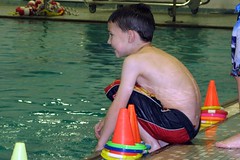A keystone is the architectural piece at the crown of a vault or arch which marks its apex, locking the other pieces into position.[1] This makes a keystone very important structurally.[2][3] In an arch, the keystone is usually larger than the voussoirs that make up the arch and may serve primarily an aesthetic purpose. Some say that a keystone is not as important structurally as the voussoirs, since the removal of any of the voussoirs would cause the arch to collapse but this is not necessarily true of the keystone.[4]The term is used figuratively to refer to the central supporting element of a larger structure, such as a theory or an organization, without which the whole structure would collapse.
Those of you who follow me regularly know about the PA Keystone Technology Integrators. Each year in the summer, a group of "tech savy" teachers are invited to participate in a week long intensive professional development program called The Keystone Summit. Most people arrive at the summit thinking they are going to learn a lot of stuff about great new tools...but they come to learn something that folks in the blogosphere have known for a long time. It is not about the tools...it's about doing new and innovative things to "Turn up the HEAT" in your classrooms. I was invited to that summit in 2005 and have been returning every year as a staff member sharing with the teachers not just technology. Every year that is, until this one. This year I had to make a difficult decision. I am working on my Administrative Certification and I needed to complete 180 hour internship. I knew that I couldn't commit the time and the energy needed to dedicate a week to be on campus for the experience and boy was I disappointed, but I did offer to do whatever I could to help create a virtual presence this year.
As I set up the wiki and ustream channels and coveritlives, embedded content and fix formatting I realized, this was just as much work as being there...without the face to face connections of being on the Bucknell campus to be with the group. Boy was I disappointed. As I listened in on some of the sessions, I missed the learning and I missed the connection. I listened in as Chris Moersch talked about ways to turn up the HEAT (Higher Order thinking, Engaged Learning, Authenticity, and Technology Use) in your classroom. I was able to sit in on many of the sessions, but this year it was different...not just because I wasn't there, but because I was thinking about all of these things through the lens of an administrator. I started to think about how as a principal or curriculum leader I could use some of the LoTi principles to change a building culture, to change the way teachers think about teaching an learning
At the last minute, a presenter was unable to make it for their workshop on Professional Development Models in the 21st Century so I thought...wow, I could teach that in my sleep so I pulled together a presentation titled 21st Century Professional Development through PLNs (with the help of my PLN) and asked if I could come and spend the day. It was what I was missing...the chance to connect, explore and innovate with some REALLY amazing teachers some teachers that will soon be leading the way in their district not because of a certification, but because of the skills they learned this week and how they reflected on these ideas...Connect, Innovate, Explore and Lead.
One of my favorite activities at Summit is during small groups where each group member is given foam blocks with the words lead, connect, innovate, and explore and think about how these 4 ideas are connected to change in schools. Back in 2007 after the summit, I wrote a post Connect, Innovate, Explore, Lead...which comes first? that shows how my group viewed it.
Each attendee is asked to think about envisioning a school that would meet the needs of students in 5 years. To build this school would require all of the ideas listed on the bricks. They were asked to "build the school" stack the bricks so to say in order of importance.




![Reblog this post [with Zemanta]](http://img.zemanta.com/reblog_e.png?x-id=80a36297-2a9b-4784-a411-250b00f884c1)











